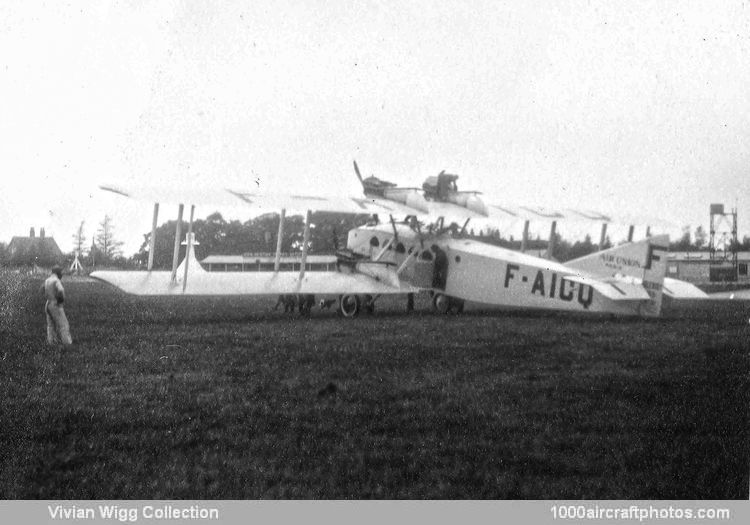The Blériot 115 was a four-engine biplane of rather unusual design. Completed by Blériot-Aéronautique in 1923, it was a two-bay biplane of equal span with four uncowled 180 hp Hispano-Suiza 8Ac eight-cylinder liquid-cooled V-engines driving two-blade wooden propellers. The engines were mounted two on the upper and two on the lower wing, and each had its own fuel tank directly behind it. The engines had self-starters and could be started in the air. It was claimed that the aircraft could take off on the power of only two engines.
The fabric covered wooden wings were untapered, and strut-connected ailerons were fitted to upper and lower wings. The all-wooden fuselage was of rectangular section with rounded decking and had accommodation for eight passengers. There were side-by-side cockpits for two crew just forward of the leading edge and another open cockpit further forward on the port side. In the extreme nose was a navigator's cabin, and its windows projected in front of the main line of the nose. The passenger cabin windows were of unusual shape, being roughly triangular with flat base, curved sides and rounded corners, similar to those used in the Caravelle more than 30 years later. The tail plane was wire-braced and the rudder horn-balanced. The main landing gear had twin wheels on each unit.
The prototype was registered F-ESBB and first flew on May 9, 1923. Unfortunately it crashed only six weeks later, June 23, at Buc, killing the test pilot Jean Casale. The mechanic on board the aircraft stated a control cable jammed or broke. A second aircraft, F-AGEM with Hispano-Suiza 8Ab engines, was registered to Société Technique Aéronautique in August 1924, for operations by Air Union. With military rudder markings and named 'Jean Casale' and 'Roland Garros', two examples were used by Colonel Goÿs for an exploration flight to Lake Chad in Niger. Piloted by Vuillemin, Dagnaux, Goÿs and Pelletier-Doisy, the two aircraft left Paris on January 18, 1925. However, after a journey of 2,571 mls (4,137 km) the flight ended at Niamey on February 5, where the 'Jean Casale' crashed to destruction. The two pilots Vuillemin and Dagnaux were seriously injured, the radio operator Vendelle was killed.
In 1924, two improved versions were built, these had seating for eleven passengers and were designated Bleriot 115bis.
The crashed prototype Blériot 115 reappeared in 1924, fitted with four 230 hp Salmson 9Ab nine-cylinder air-cooled radial engines and given the designation Blériot 135. In this form it first flew on July 19, and finished second in the 1924 Commercial Aircraft Grand Prix. This and a new-built example, each with accommodation for ten passengers, were used by Air Union on the Paris-London route. The first flight over the route by a Blériot 135 was on August 8, 1924.
Also in 1924 Blériot began study of a further development of the design, this resulted in the Blériot 155, which first flew on July 29, 1925. It was similar to the earlier types, but slightly bigger and heavier, and powered by four 230 hp Renault 8Fg eight-cylinder liquid-cooled engines. The forward fuselage was modified, the navigator's cabin eliminated and the two-seat cockpit moved forward. The rudder was no longer horn-balanced, and the leading edge of the heightened fin was curved. Accommodation was provided for seventeen passengers.
Two Blériot 155s were built, both were operated by Air Union on the Paris-London route, the first Blériot 155 flight over the route being on May 19, 1926. These aircraft had short working lives.
F-AIEB crashed near Ashford in the UK on a scheduled flight from Le Bourget, France to Croydon, UK, on August 18, 1926. Over the British coast the crew encountered bad weather and the pilot decide to make a precautionary landing. Due to poor visibility, the aircraft hit a barn and crashed, the pilot and two passengers were killed, the mechanic and the remaining eleven passengers were injured.
F-AICQ, also on a scheduled flight from Le Bourget to Croydon, crashed near Leigh, UK, 18 mls (29 km) short from its destination, on October 2, 1926. The upper-right engine caught fire, and the pilot attempted an emergency landing at nearby Penshurst Airport. Subsequently the aircraft rolled over and fell to the ground, the two crew and five passengers were killed."
|
|
Blériot 115 |
Blériot 115bis |
Blériot 135 |
Blériot 155 |
